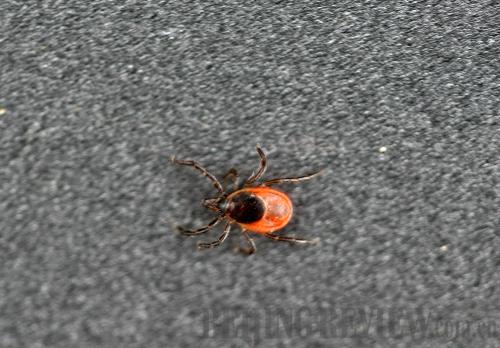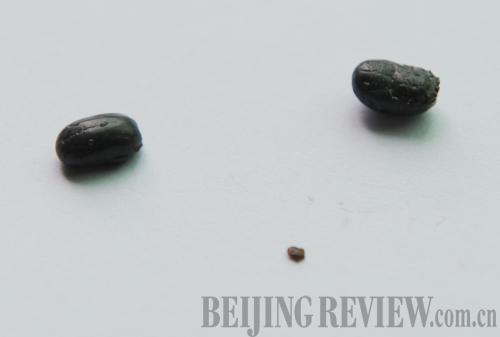|
 |
|
TICK ALERT: A tick sucking blood and transmitting diseases (IC) |
 |
|
LETHAL BUGS: Three tick specimens at the Shangcheng County Center for Disease Control and Prevention on September 10 (ZHAO PENG) |
A new bunyavirus has already been isolated as a possible pathogen of the tick bite cases in several Chinese provinces including Henan.
But so far experts cannot confirm the virus is the culprit causing the infections, said Wang Shiwen, a researcher with the Virology Institute at the Chinese Center for Disease Control and Prevention (CCDC).
Despite the pathogen remaining unclear, "there is no need to panic as the disease can be cured with timely detection and treatment," he said at a September 12 workshop on the epidemic in Henan's Shangcheng County.
Bite cases
On September 8, the Henan Provincial Center for Disease Control and Prevention reported 18 deaths from the disease from tick bites to the Ministry of Health (MOH).
The 18 victims were among 557 reported cases of suspected human granulocytic anaplasmosis (HGA) since May 2007, when the ministry began receiving reports, said Xu Bianli, Deputy Director of the Henan Provincial Center.
Given that it is harvest season and the tick is usually spotted in fields, the MOH issued online prevention tips, such as wearing long pants outdoors.
The disease is often reported between May and August and most of the afflicted are between 40 and 70 years old, experts said.
Patients suffering from the disease show symptoms of fever and a reduction in the number of platelets and white blood cells, which can lead to organ failure and death.
People in close contact with patients can also be infected if no precautions are taken.
Most of the cases were found in Xinyang City's Shangcheng and Guangshan counties, said Xu.
Shangcheng County alone reported 120 cases, including one death, between January and September 8, he said.
Ticks have existed in the area for years. They are parasitic arachnids attaching themselves to human skin, sucking blood and transmitting diseases. They can grow from the size of sesame seeds to as big as soybeans after being sated with blood.
Apart from Anhui Province, where it was first detected in 2006, the infection has surfaced in six provinces on the Chinese mainland, including Henan, Shandong and Hubei, he said.
On September 10, Shandong also reported that 13 people died after contracting infections from tick bites in the province. The victims were among 182 reported cases of suspected HGA since May 2008, when the province started monitoring the disease.
Many of the patients were bitten by hard ticks, according to a statement from Shandong's health department.
Shandong is educating the public about the disease and training doctors to treat it.
But even today the specific pathogen causing these infections remains largely unknown, said Diao Linqi, Deputy Director of the Henan Provincial Health Department's Disease Control and Prevention Section.
Chinese experts have yet to determine the type of pathogen carried by ticks, Li Dexin, Director of CCDC, said at a press conference on September 10.
Now, the center has temporarily named the disease "fever-thrombocytopenia syndrome," but many kinds of pathogens are likely to cause the syndrome, said Li. Ticks can carry 83 kinds of viruses and 14 kinds of bacteria, he added.
"We are handing out flyers to tell people if they have fevers, they must see a doctor as soon as possible," Li Wenxue, a doctor at Hutai Village, Jingangtai Township in Shangcheng County, told Xinhua News Agency.
Worldwide, similar infections from tick bites have been detected in many countries like the United States, but with no casualties reported, according to WHO.
Medical personnel in affected countries should be trained to be aware of the infection and rate of occurrence, said WHO.
The emergence of some insect-borne infections and diseases might be related to the effects of global warming, some international experts warned.
No need to fear
On September 12, the MOH sent clinical experts to Xinyang to help local doctors diagnose the tick-borne disease and contain its spread.
Henan sent experts to Xinyang in early April. Meanwhile, to probe the real cause of the disease, the CCDC ordered local disease control agencies to closely monitor the disease, said Xu.
Early in 2008, the MOH issued a guideline for the prevention, diagnosis and treatment of the disease, which says that local health authorities report suspected cases within 24 hours of detection.
The ministry said the disease is curable if treated soon enough. Transmitted in a similar way as pathogens carried by mosquitoes, the illness is also preventable, Xu said.
Chinese health authorities have been trying hard to quell public fear about the tick-borne disease. Experts sent by the MOH to the site in Henan outlined preventative measures on September 12.
The MOH has designated experts to develop new clinical guidelines for the diagnosis and treatment of the tick-borne disease. | 